MILITARY PLANNING
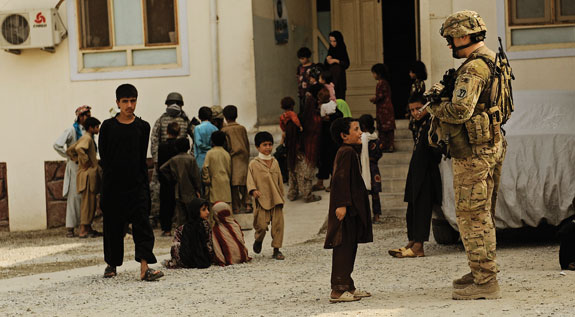
DoD photo United States Air Force photo by Ryan Crane
Soldier speaking with boy in front of school
Design and Joint Operation Planning
by Daniel R. Green
Lieutenant Colonel (ret’d) Dan McCauley is a former United States Air Force officer who is currently a National Defense University assistant professor teaching at the Joint and Combined Warfighting School (JCWS) in Norfolk, Virginia. Professor McCauley served for 25 years as a B-52 and KC-135 instructor pilot, and in various staff capacities, including tours at the NATO AIRSOUTH Headquarters in Naples, Italy, and as a faculty member at the Canadian Forces College (2002-2006). He has served as the JCWS Strategy and Theater Campaign Planning course director, and, in addition to normal teaching responsibilities, has taught electives on NATO, The Interagency, and Joint Air and Space Power.
“For all cases, the CCDR [combatant commander] must work to frame the problem with the best information available and be prepared to reassess the situation and reframe the problem, as required.”
~Joint Publication 5-0, Joint Operation Planning1
For more information on accessing this file, please visit our help page.
Introduction
The current strategic operating environment in which US military forces operate has changed significantly in the past 20 years.2 The US military has shifted its strategy from a reactive, conventional-planning focus to one that encompasses a proactive, shaping strategy that focuses on a broad array of threats. Inherent within this shaping strategy is the requirement to set environmental conditions that directly or indirectly support US goals and objectives.3 To develop and execute a successful strategy, an in-depth understanding of the social make-up of the environment, to include the cultural, historical, religious, economic, and political aspects of that social framework, is necessary. Today’s military strategists and operational planners must be able to visualize the environment in all of its complexity to understand the competing actors and interests required in a shaping strategy.
This ability to visualize actors and trends in time and space is known as operational art, further defined as the application of creative imagination by commanders to design strategies, campaigns, and military operations to organize and employ military forces.4 To apply operational art, the commander draws on characteristics such as judgment, perception, and character to visualize the environmental conditions necessary for success.5 In today’s environment, the commander must be able to integrate US military, Department of State, and other US governmental organizations, allies, and host nations to properly ‘shape’ the environment to attain US goals and interests. Some officers can perform this intellectual process intuitively, but most must rely upon a framework or process that informs and guides the understanding, design, and development of strategies and plans. Operational design and the joint operation planning process (JOPP) provide a framework that staffs and planning groups can use to give strategic leaders, commanders, and warfighters a better understanding of the nature of the problems and objectives for which we are committing, or planning to commit, American forces.
Our current processes tend to be product-oriented, and can lack a focus on understanding the environment, specifically the proper identification of the problems causing undesirable environmental conditions. Because of this, a new effort is afoot to instill greater intellectual rigor and imagination necessary when planning for military operations that have their root causes within a complex social environment. The new effort is currently called ‘design,’ and focuses upon efforts to better understand the full range of socially-complex,6 interactive7 problems that face planners. Design originated in a concept developed in the early-1970s by Professors Horst Rittel and Melvin Webber from the University of California, Berkley. Rittel and Webber were urban designers who originally coined the term ‘wicked’ problems to describe the intensely challenging ill-structured, complex nature of social problems that traditional linear systems approaches of the early industrial era8 inadequately address. The US Army recently adopted this concept to underpin its current doctrinal thoughts that address the types of problems associated with stability and reconstruction efforts and irregular warfare operations in Iraq, Afghanistan, and elsewhere.9
Design is not new. In fact, commanders and staffs have performed deliberate or hasty intuitive design since the inception of military operations. The ‘new’ approach to applying design refocuses our efforts on identifying the underlying problems in the environmental conditions contrary to US national interests. This renewed focus on irregular warfare, the shift in strategy to proactively shaping the environment, and missions that encompass stabilization and reconstruction efforts require planners to think in a more thorough strategic context. That more detailed context includes social, political, economic, religious, and cultural considerations, among others, and stresses the importance of understanding whether the actions taken are the right ones for the interconnected environment within which we live. As most problems are essentially social, much of the background and many of the concepts that form the basis for design in military planning are adapted from the concept of ill-structured, socially complex or ‘wicked’10 problems. This increased understanding of the environment requires planners to take a much broader approach to planning, to include a whole-of-government approach, to these types of operations. The concept of design, its method, and applicability to operational level planning provides for a better understanding of the mutually supporting relationship of design and planning and requires further examination.
The Concept of Design
In the context of social problem-solving, there are typically two types of problems: well-structured (tame) and ill-structured (wicked).Well-structured problems belong to a class of similar problems, are relatively well-defined, and have a stable problem statement, limited solutions, a definite stopping point, and a specific end-state. Typically, planners can objectively evaluate solutions as ‘right’ or ‘wrong.’ Well-structured problems often permit planners to make many attempts at determining a solution without changing the nature of the problem – in short; they can try and abandon solutions at will.11 Well-structured problems can be complex, but because of their inherent logic and stable problem statement are typically ‘solved’ over time.

DoD photo by Scott Dunn
US Navy Amphibious Support Ship
Ill-structured problems, which include most social problems,12 do not generate a specific answer with any certainty. In ill-structured problems, multiple systems and actors interact, and, as such, information is often in conflict or inclusive. The relative position of the actor to the issue defines the nature of the problem. Stakeholders may recommend different solutions to the problem, many of which are in direct opposition to one another. There are no clarifying traits of these wicked problems and they are, at best, poorly defined. These types of problems rely upon “judgment” for resolution and, thus, are never solved – only re-solved time and again.13 Ill-structured problems are typically complex, and it is this combination that the design concept is intended to address.
In the past, ill-structured problems were the purview of relatively few individuals. Today, social problems underpin all military operations, and are at the forefront of any planning effort. The notion of wicked problems attempts to reconcile the dilemmas posed by social planning problems. Rittel and Weber posited that there was a whole realm of social problems unsuccessfully treated with traditional, linear, analytical approaches.14 Scientific formulas for addressing social problems are doomed to failure because of the interactive nature of the problems.15
In the case of wicked problems, the search is not for the truth, but rather for an acceptable solution that will improve some characteristics of the world within which we live.16 War or conflict is ultimately the result of inherently complex social problems. When we put them into the contexts of groups, tribes, sects, nation-states, or regions, the social complexity reaches staggering proportions. Add into the mix history, culture, religion, and any number of other factors, and the concept of a wicked problem emerges.Understanding the nature of these problems will not guarantee the ‘correct’ solution to an undesired condition, but will enable the planner to define the problem and to perhaps determine a ‘better’ or acceptable solution.
Relatively tame problems, when applied to conventional military operations, underpin typical military problem-solving. Although there is a level of complexity, an inherent and deterministic logic underpins traditional warfighting operations. Planners can apply certain principles to contingency planning for traditional warfighting. Once planners understand relationships between the parts of the problem, they recognize that every action has a consequence, and although some actions reinforce the adversary system’s power, others degrade that power. The typical wargaming method of action, reaction, and counteraction significantly contributes to this oversimplification of combat, which, after all, is a human endeavor and thus subject to fog and friction. Traditional wargaming is an extremely useful tool, but planners must understand that whereas the wargaming outcome is deterministic, combat is not. In complex, ill-structured problems, wargaming is still required, but the real benefits do not necessarily come from the results. The far greater benefits are derived from the discussions of possibilities and probabilities from the interaction of systems and actors within and between systems.
Design is a methodology for applying creative and critical thinking to understand, visualize, and describe complex, ill-structured problems, and to develop approaches to solve them. Design is a focused inquiry that enables the commander and staff to make sense of a complex situation, capture that understanding,17 and share the resulting cognitive map. Commanders use design to frame the environment, identify conditions contrary to US national interests, and describe the tensions resident in potential future conditions that describe a problem we must solve or manage. From that understanding of the environment, a critical analysis of the problem compared to the desired outcome based on projected future conditions occurs. The products of environmental and problem framing lead to the development of potential solutions. The design method is iterative, relies upon constant inquiry, and is inherently non-linear. Systems thinking and discourse based upon learning and assessments enable design and continue throughout planning and execution.18 For example, in Kosovo the desired political solution (essentially a Serbian-free Kosovo province) was developed in isolation from the realities of the environment. The strategic end state failed to consider the existing conditions, the potential actors, the tendencies within the environment, internal and external relationships, the patterns of resistance, as well as the opposition to or support of any proposed solutions. The 78-day bombing campaign was thus constrained and distorted by a clear lack of vision of the desired solution based upon competing interests and a poor understanding of the environment and the problem therein.19 Whereas the air component had sufficient forces to punish the Serbs, it did not possess enough to halt unilaterally the ethnic cleansing, resulting in an extended campaign.20 It was only after senior commanders essentially redesigned the campaign that NATO was able to attain the desired end state.
A plan is defined as “a method for achieving an end” or “an orderly arrangement of parts of an overall design.”21 Typically, planning is broken down into two smaller related processes: a design component and a detail component. The design component provides the general framework of the desired end or objective, a common statement of the problem or issue, the relationship of the problem to the environment, and a general description of the ‘ways.’ The detail component specifically addresses the ways and means to achieve the desired goal or end state. Any number of problem-solving models may be used in a planning process, but the JOPP enables planners to address both the design and detail components simultaneously. During planning, these components overlap and there is no clear demarcation between them. As commanders and staffs progressively address their concept of an operation, they further refine the design and incorporate it into the plan. An ensuing visual understanding of the environment necessitates a cognitive map that depicts the complex relationships at work within the environment.
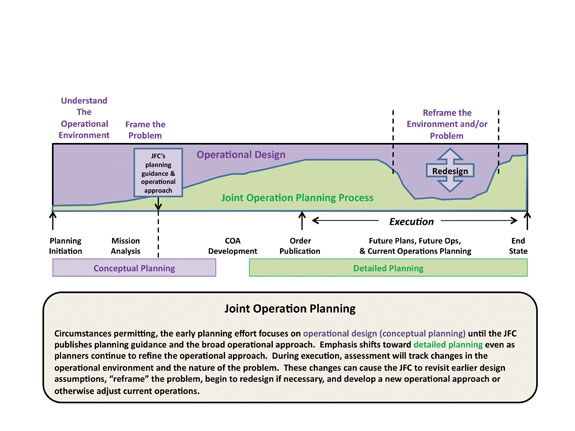
DoD Planners Handbook for Operational Design, Joint Staff J-7, Joint and Coalition Warfighting, Suffolk, VA
The Balance of Operational Design and JOPP
One of the first questions that comes to mind is why should we study design? The primary reason is the almost singular focus on the operational level of war since the conclusion of the Second World War may have clouded our ability to see problems outside of a conventional warfare context. The environment and the actors within the contemporary environment are difficult to understand, and, as a result, solutions or potential solutions to problems are difficult to develop. Linking the actors within the environment to a comprehensive understanding of the environment itself requires the ability to think strategically. Strategic thinking is difficult, partly because the majority of our professional careers are spent developing tactical expertise in which linear thinking and relatively well-structured problems and solutions exist. Strategic thinking requires an ability to think in a non-linear and imaginative fashion that is outside the majority of most of our comfort zones. As future operations will most likely be within the irregular warfare or hybrid warfare realms, the dilemmas posed by complex problems will frustrate conventional thinkers.
As the military is more frequently asked to solve problems that have their basis in social inequity or competition, the complex social patterns and underlying root causes resident in the strategic environment create a difficult task for today’s planners. The involvement of a multitude of actors – some supportive, some adversarial, and others neutral – in these types of settings, as well as an understanding of their motives and whether they are in opposition to our own motives, adds an almost overwhelming level of complexity to these problems. The actors within the strategic environment operate within a social mosaic that is difficult to understand – the social structure and norms, religions, classes, tribes, relationships, histories, and other considerations add yet more levels of complexity. We must thoughtfully consider the impact of all of these complexities on our desired actions as we integrate all elements of US and multinational power in a unified effort.
Design Methodology
Three distinct elements collectively form a design concept.22 These three elements, –environmental, problem, and solution frames – constitute a learning methodology that corresponds to three basic questions to answer to produce an actionable design concept:
- What is the context in which the design will be applied? (Environmental Frame)
- What problem is the design intended to solve? (Problem Frame)
- What broad, general approach (es) will solve the problem? (Solution Frame)
During design, the commander and staff consider the conditions, circumstances, and factors that affect the desired conditions or our ability to act within the environment. It is through the understanding and synthesis of both the current conditions and desired conditions that staffs develop approaches that aim to satisfy those desires. As potential solutions are developed, commanders and staffs may realize that their initial assessment of the problem was inaccurate or incomplete so they continue to frame the problem, which, in turn, requires adjusting the solution.23
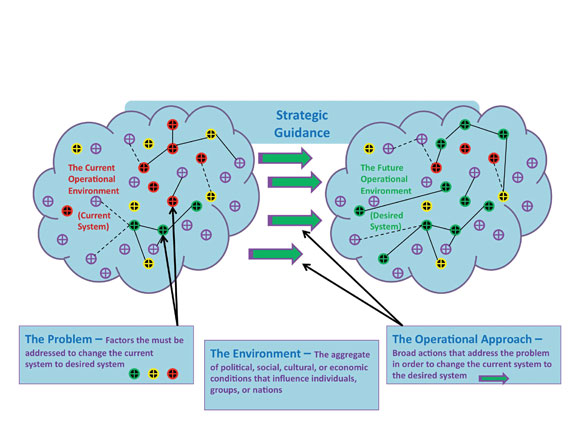
DoD Planners Handbook for Operational Design, Joint Staff J-7, Joint and Coalition Warfighting, Suffolk, VA
Design Components
The Environmental Frame
Environmental framing involves organizing, interpreting, depicting, and generally attempting to make sense of a complex reality to provide guideposts for subsequent frames. It incorporates everything within the political, military, economic, social, information, and infrastructure (PMESII) construct, plus history, culture, and all the relationships contained therein. It also includes identifying the environmental actors and trends, competing strategies, and inherent tendencies within the system. Environmental framing must also include the reason for the strategy or plan. This frame facilitates hypothesizing or modeling that bounds the part of the environment and initially describes the problem under consideration. For example, the decision to launch Operation Iraqi Freedom should have not only addressed the removal of Saddam Hussein for his possession of chemical weapons and potential to support terrorist organizations, but also articulated other reasons his regime’s removal was necessary. Specifically, the decision should have addressed the repercussions for failing to remove Hussein; the political, religious, and social systems that supported or opposed his regime; potential supporters and competitors within and between those systems; external actors and their strategies; and a description of the future role of Iraq within the region. Furthermore, considering factors such as the identification of US interests in Iraq, in the region, and globally at that time, along with the risk associated with acting or not acting, would add additional granularity to the environmental frame.
Understanding the operational environment begins with analyzing the context of the situation in accordance with guidance and direction from a higher authority. An understanding of the current and projected environment, why some aspects of it are unacceptable, and the desired outcome are necessary to a valid design. Commanders and their staffs review relevant directives, previous guidance, and missions and inform their higher authority of new information or differences in the initial understanding of the environment. Commanders and staffs also confirm the desired end state, if provided by the higher authority, or propose their own.
When discussing current conditions in relation to desired conditions, the dynamic nature of the environment must be understood. Left alone, the environment would progress toward some future condition, either in rational and predictable ways, or else in irrational and chaotic ways. Some environmental conditions would be desirable from a US perspective, whereas others would be undesirable or perhaps neutral. The shift in US strategy to ‘shape’ those future conditions sets in motion the requirement for US forces to conduct operations worldwide. These operations or activities are attempts to reinforce positive environmental conditions, and mitigate or eliminate undesirable ones. Our actions, predicated upon national interests and acceptable risk, are re-evaluated over time as conditions change.
Just as the US desires certain conditions, individuals, groups, organizations, and other nation-states have similar desires based upon their own particular circumstances and interests. Some of those desired conditions parallel our own desires, whereas others diverge or are in direct opposition. As the US acts in its self interest, the environment (depending upon the interactions between the interests in question) reacts or responds accordingly. Hence, the environment and the environmental frame are in a constant state of flux. Depending upon the nature of the environmental change, planners may need to re-evaluate the problem and solution frames.
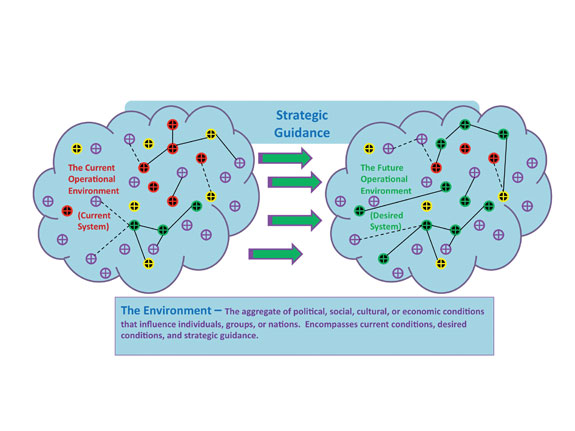
DoD Planners Handbook for Operational Design, Joint Staff J-7, Joint and Coalition Warfighting, Suffolk, VA
The Environment
The Problem Frame
The problem frame refines the environmental frame, and defines the areas for action to transform existing conditions into desired conditions. The problem frame extends beyond analyzing interactions and relationships in the environment. It identifies areas of tension and competition – as well as opportunities and challenges – that commanders must address to transform current conditions into desired conditions. Tension is the difference between the existing conditions and the desired conditions, which are most likely in conflict with others’ desires as well as the natural environmental tendencies. This tension is further exacerbated by the resistance or friction between actors or within the environment that often provides the basis for the problem’s root cause or driver identification. The commander and staff identify the root causes by analyzing the relevant actors’ tendencies and potential actions.
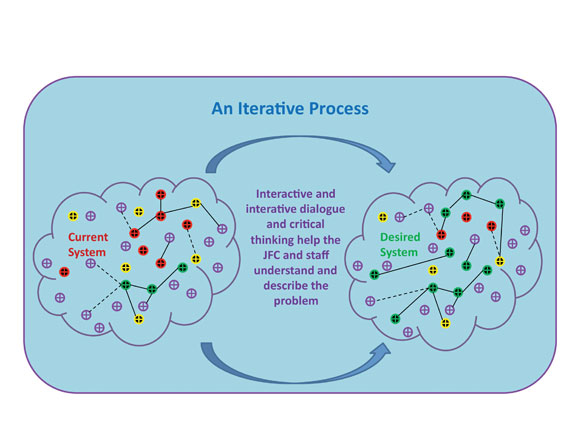
DoD Planners Handbook for Operational Design, Joint Staff J-7, Joint and Coalition Warfighting, Suffolk, VA
Describe the Problem
In the problem frame, analysis identifies the positive and negative implications of acting upon the root causes in the operational environment given the differences between existing and desired conditions. When the commander and staff take action within the operational environment, they may exacerbate the root cause. Root causes identification is vital to transforming existing conditions and is exploited to drive change. If left unchecked, other tensions may undermine the transformation and must be addressed appropriately. As tensions arise from differences in perceptions, goals, and capabilities among relevant actors, they are inherently problematic and can both foster and impede transformation. By deciding how to address these tensions, the commander sets the problem that the design will ultimately solve.24 The root cause may not be solvable in the proposed time frame nor may the resultant conditions of its removal be acceptable. As a result, commanders must be willing to take an indirect approach to the problem by addressing conditions that minimize the effects of the root cause.
The Solution Frame
The solution frame is a conceptualization of the general actions that will produce the conditions defining the desired end state. In developing operational approaches, commanders consider the direct or indirect nature of interaction with relevant actors and operational variables in the operational environment. As commanders consider various approaches, they evaluate the types of defeat or stability mechanisms that may reduce the tensions between potential conditions that can define the end state. Thus, the solution frame enables commanders to visualize and describe possible combinations of actions to reach the desired end state given the tensions identified in the environmental and problem frames. During courses of action development in detailed planning, the solution frame provides the logic that underpins the unique combinations of tasks required to achieve the desired end state.
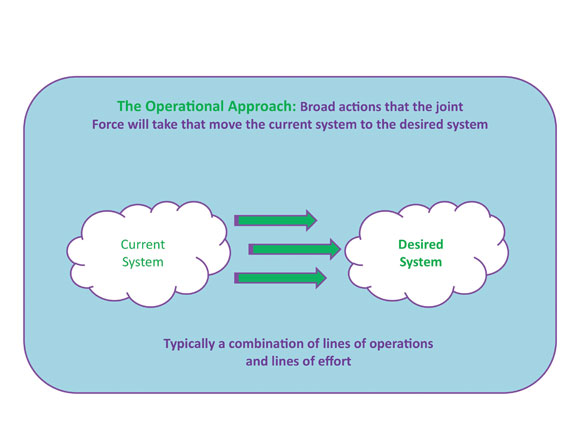
DoD Planners Handbook for Operational Design, Joint Staff J-7, Joint and Coalition Warfighting, Suffolk, VA
The Operational Approach
One method to depict the solution frame is to use the elements of operational design, specifically logical Lines of Operations (LOO), which depict the links among tasks, objectives, conditions, and the desired end state. Design offers the latitude to portray the solution frame in a manner that best communicates its structure through a graphic depiction. Ultimately, the commander determines the optimal method to address the solution. To ensure the operational approach is understood, a detailed narrative must accompany the LOOs.25 For example, further clarification of a LOO entitled Engage Libya explains the current political, social, and military conditions within Libya that necessitate current and future engagement with the ultimate objective of developing Libya as an active US partner in the region. The LOOs and associated elements facilitate the visualization of a detailed cognitive process.
Design as Applied to Strategy and Planning
Strategies and plans are a reaction to or are in anticipation of a potential adverse environmental stimulus, and link ends, ways, and means to address identified problems. As such, the application of the design methodology to either a strategy or plan is appropriate. In fact, design, with its foundation squarely derived from the concept of ill-structured problems, is most appropriately applied in the strategic context.
One of the key elements to understanding the nature of the environmental and problem frames is a comprehensive understanding of a requirement for the strategy or plan in the first place. The President or Secretary of Defense must make a value judgment that something within the environment is significant enough to require the use of one or all of the elements of national power. Along with that value judgment should be a description of the breadth and depth of the intended strategy or plan. Without a clear understanding of the inherent relationships and tensions within the environment and an appreciation for the level of national interest and associated risk, a poorly-scoped mission intended for a short duration can quickly become a long-term effort costing lives, resources, and opportunities. Subsequently, this limits the ability to act within the environment when more vital national interests are at stake.
Applying Design to Operational Planning
How design is accomplished is the fundamental question. In the environmental frame, value judgments determine whether a problem exists, and are made again when considering a response. Understanding that the level of interest of those espoused values can change over time due to a number of factors will affect the very nature of the environmental frame.
The first step is to frame the environment by describing the context of the current situation. Using a framework such as PMESII, joint intelligence preparation of the operational environment helps provide an initial structure to build a cognitive map of the environment.26 As planners understand systems and relationships, they can develop a common understanding by using maps that visually depict those relationships. Inherent within the current environment is the concept of time: history provides an understanding of current actors and their relationships and an understanding of environmental trends provides possible futuristic scenarios. Considerations incorporated within this framework include US domestic and international factors, including worldwide operations and the level of interest and risk associated with each.
An analysis of strategic direction must occur as that guidance applies value to specific aspects of the environment. Guidance provides the limits of the operational environment by applying constraints, restraints,27 and other limitations through the issuance of orders, policy, and law. The current conditions, strategic guidance, stated values, and desired end state assist in establishing the limits of the environmental frame.
As a result of the analysis and assessments performed in the environmental frame, the problem frame is a natural continuation of that process. The difference between our desired conditions and the desired conditions of others provides the breadth and depth of the problem. In some instances, keeping the status quo is desired, whereas in others, given time and resource constraints, only a subset of those desired conditions can be addressed. The environmental frame describes the actors, trends, tendencies, potentials, and relationships within the environment that have equities in any potential solution. As planners address the differences in potential conditions, those tensions create patterns of support and opposition to any proposed solution. The participants' relationship to the problems defines the level of support or opposition to any proposed solution.
If the problem frame is acceptable to higher command authorities, the solution frame is addressed by planners. Any potential action must take time, space, resources, risk, level of national interest, and purpose into consideration when developed. Given those variables within any solution, the planner may determine that there is insufficient time or resources available to create the desired conditions or that their cost is excessive. If so, modification of the guidance must occur in some form, to include limiting desired expectations, dedicating additional assets and resources, or reevaluating the costs, benefits, and risks. For example, if the planners for Operation Iraqi Freedom had determined that the US would still be in Iraq eight years later at the cost of hundreds of billions of dollars, perhaps strategic leadership would have re-evaluated the costs, benefits, and risks and determined that more limited objectives may have been more desirable.
Figure 1 represents a visual depiction of the relationships between the frames and some of their major components. Describing and understanding the existing conditions within the environmental frame is the first step in the process. As consideration is given to the problem and solution frames, planners must keep in mind the relationship to and the impact upon the environmental frame of any activity and the subsequent impact upon those two frames.
An Approach to Design Application28
Developing these three frames through a problem-solving framework forms the basis for a strategy or plan design concept, and will provide the necessary details for the narrative and graphics needed for a fully fleshed out plan. The problem statement generated during problem framing communicates the commander’s understanding of the problem upon which the organization will act. Together, these three frames are part of an iterative process that occurs throughout strategy or plan development.
Framing and Reframing
The concept of design uses the terms ‘framing’ and ‘reframing’ to describe the process through which one attempts to apply some order to the environment, problem, and potential solutions. An iterative process that considers the interactive and reactive nature of the environment, as well as the effects any proposed or actual actions have on that environment, connects these frames. The very nature of this process requires an in-depth deductive analysis or framing of the environment to identify and understand the basic components of the system in question and the supporting or connected systems. The initial framing of the environment and the value judgments applied to the level of acceptability of current conditions constitutes the “framing of the problem,”29 and occurs in the mission analysis step of JOPP.30
As planners identify potential problems and consider potential solutions, there is a need for increased specificity of the environment to meet those demands. As a system is broken down for greater understanding, inconsistencies and ambiguities are found that render our previous understanding inaccurate or false. Just as it seems chaos is the only result of this process, the modification of the system imposes order. This modified system pieces together patterns and ideas into a generalized concept that enables greater understanding of the underlying chaos. This cyclical process could continue in perpetuity in pursuit of ‘perfect’ knowledge, so commanders determine the degree of knowledge necessary to satisfy the basic goal.
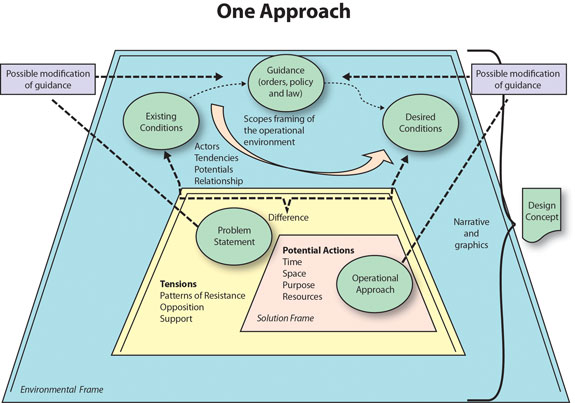
Daniel H. McCauley from Colonel Marco McCaffrey, JFCOM J7 to Joint Warfighting Center, Enhancing Operational Design in Joint Doctrine, 12 August 2009.
An Approach to Design Application
Reframing occurs when any change in the environment or understanding of the problem significantly refines or causes one to discard the hypotheses or models that form the basis of the design concept. Just as the environmental frame is always evolving, the problem and solution frames must also evolve. Reframing criteria support the commander’s ability to understand, learn, and adapt—and cues commanders to rethink their understanding of the operational environment, the problem, and potential approaches.
Problem Framing/Reframing as Applied to the Elements of Operational Design
To understand ‘conditions’ and related terms as used here, a few definitions are in order. Conditions are not currently an element of operational design nor is the term defined in Joint Publication 5-0. Conditions are, however, defined in Joint Publication 1-02, Department of Defense Dictionary of Military and Associated Terms, as “Those variables of an operational environment or situation in which a unit, system, or individual is expected to operate and may affect performance.”31 Joint Publication 2-01.3, Joint Intelligence Preparation of the Operational Environment, does not use the term ‘conditions’ when describing the environment, but does use the phrase “characteristics of the operational environment.”32 In short, when contemplating the use of the current elements of operational design, conditions are those characteristics that exist within the environment.33
The elements of operational design may be used in part or in sum in any of the three frames. For example, in the initial framing of the environment, the assessment describes the current conditions and desired end state. The problem frame further incorporates many of the design elements, such as objectives, termination criteria, center of gravity, and some of the decisive points (DP). The solution frame forms the operational approach and will typically use many of the remaining elements, such as effects, DPs, direct/indirect approach, LOOs, and others.34 The symbiotic nature of the operational approach to the problem and environmental frames, however, requires the planner to apply the elements of design in an iterative fashion as the frames are addressed. In addition, as each situation is essentially unique, planners may need to creatively adapt some of the terms to fit the situation, which represents the flexibility and adaptability required within complex problem-solving.
The Relationship between Design and Assessments
Assessments are defined as “… a process that measures progress of the joint force toward mission accomplishment. Commanders continuously assess the operational environment and the progress of operations, and compare them to their initial vision and intent.”35 Assessments, an integral part of design and any planning effort, historically have focused upon the adversary and have failed to address the population, the economy, and other aspects of a dynamic environment that make up a wicked problem.36 Typically, only after the planners have developed potential courses of action and the commander has selected one for execution is an assessment strategy developed. By that point, planners have missed not only the opportunity to provide the right mechanisms for assessing the outcomes of the planned activities, but also the opportunity to further understand the environment and nature of the problem through operational research. Typically, planners view assessments as a formal ‘after-the-fact’ activity. In reality, assessments are made throughout the entire planning and execution processes. For example, an initial assessment of an undesirable condition within the operating environment requires a prior baseline assessment to make a value judgment that will drive operations. Assessments come in many forms: formal, informal, internal, external, subjective, and objective, to name just a few.
Assessments are a critical component of design because they are the only way to define the initial problem and to anticipate, create, and recognize change, opportunities, and transitions. Throughout the design process and any operations planning process, planners must recognize and exploit assessment opportunities. Understanding the iterative nature of both the design concept and the operations planning process will provide planners myriad opportunities to frame and reframe the problem to ensure they are solving the right problems.
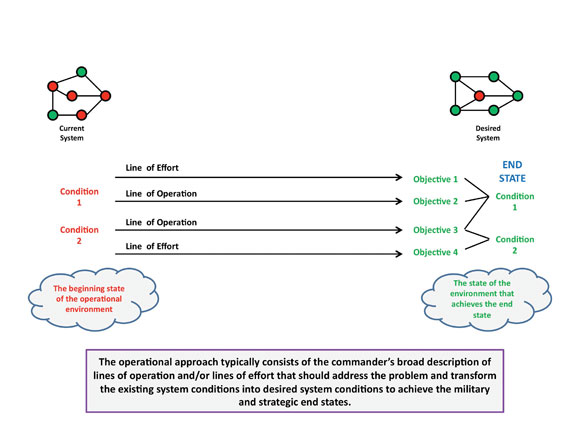
DoD Planners Handbook for Operational Design, Joint Staff J-7, Joint and Coalition Warfighting, Suffolk, VA
Operational Approach – The Basics
Conclusion
Without a peer competitor on the immediate horizon, the US has shifted its focus to a shaping strategy that relies upon influencing events today so that major combat operations are unnecessary in the future. Inherent within this strategy is a need to understand the global strategic environment, the actors, trends, and other influences either in support of or in opposition to our efforts. By far, the majority of future military operations will encompass complex ill-structured problems. Commanders and staffs must be able to integrate the whole of the US Government to shape the environment properly in pursuit of US goals and interests.
The concept of design relies upon systems thinking and offers a way to apply strategic thinking to more accurately visualize the operating environment. Through its three frames, design assists the commander and staff with a better understanding of current and desired conditions so that operational art can be more effectively employed in the development of force employment options. The iterative nature of the design method – intrinsic to the traditional planning processes – provides the commander with a continual assessment of the environment, problems, and solutions and their interactive relationships focusing efforts on solving the right problem. Without the unique perspective offered by design, the linkages between the environment, problem and solution within a complex environment are typically poorly or improperly defined.
Design will never overcome uncertainty or chaos, but it will help the planner understand the interactive and changing nature of the types of environments within which US forces will operate in the future. Knowing how to apply these concepts in the development of a strategy or plan and understanding the symbiotic relationship of design elements will go a long way in ensuring that a plan, although perhaps not ‘right,’ is at least not making the situation worse. Often when addressing wicked problems ‘good enough’ will be as good as it gets. We may not, however, even reach ‘good enough’ if we fail to embrace the process of design.
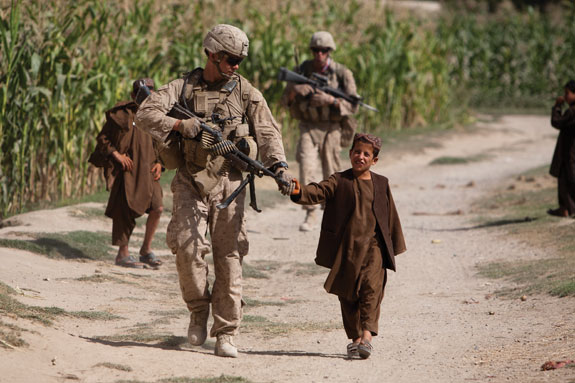
DoD photo by Jason Morrison
Soldier walking hand-in-hand with boy
Notes
- Joint Publication 5-0, Joint Operation Planning (Washington DC: Joint Chiefs of Staff, 2006), III-5.
- The Joint Operating Environment, (Suffolk, VA: United States Joint Forces Command, Center for Joint Futures, 2008), pp. 3-4.
- Quadrennial Defense Review, (Washington, DC: Department of Defense, February 2010), pp. 6-9.
- Joint Publication 5-0, iv-3.
- Joint Publication 5-0, xvi.
- Jeff Conklin, “Wicked Problems and Social Complexity,” Dialog Mapping: Making Sense of Project Fragmentation, 2005, http://www.cognexus.org/id42.htm, pp. 12- 15. (Accessed 24 February 2010) According to Conklin, social complexity is “… a function of the number and diversity of players who are involved in a project. The more parties involved in the collaboration, the more socially complex it is. The more different those parties are, the more socially complex.” As each party involved has its own purpose, goals and perspective relative to the issue, as well as a specific history, culture and even language, the problem becomes increasingly complex.
- Horst W. Rittel and Melvin M. Webber, “Dilemmas in a General Theory of Planning,” in Policy Sciences 4, No. 2, (1973), pp. 156, 167. Rittel and Webber discuss the nature of the contemporary environment in the context of interacting open systems. An open system is one that continuously interacts with its environment and is representative of today’s global environment.
- Ibid., pp. 157-160. Rittel and Webber discuss the meaning of ‘wicked’ and explain that it is intended to convey a meaning similar to “tricky (like a leprechaun)” or “vicious (like a circle)” and is not intended to imply maliciousness.
- The most recent published document is the TRADOC Pamphlet 525-5-500, The United States Army Commander’s Appreciation and Campaign Design, Version 1.0, 28 January 2008. The soon-to-be-released DRAFT Field Manual 5-0 incorporates these ideas and further expands upon them. The initial draft of Joint publication 5-0 incorporates many of the same concepts and ideas.
- Rittel and Webber, p. 160. Rittel and Webber use the term ‘wicked’ to describe problems that urban planners typically encounter, specifically social and/or policy planning, and the elusive search for solutions to these ill-structured problems. They identify at least ten distinguishing characteristics of planning-type problems and apply the term ‘wicked’ to illustrate the complexity of the issues.
- Jeff Conklin. Rittel and Webber first used the term ‘tame’ to describe those problems in contrast to wicked problems, but did not provide a definition or examples of such problems. Conklin defined a tame problem and provided the six characteristics of such problems mentioned above.
- Rittel and Webber describe social problems and other governmental planning issues as public policy issues, p. 160.
- Ibid.
- Tom Ritchey, Wicked Problems: Structuring Social Messes with Morphological Analysis, 2005-2008, Swedish Morphological Society.
- Rittel and Webber, p. 155.
- Ibid., p. 167.
- USAWC Campaign Planning Handbook AY 10, (Carlisle, PA: Department of Military Strategy, Planning and Operations, 2010), p. 29.
- TRADOC Pamphlet 525-5-500, p. 6.
- Kosovo Report: A Report From The Independent International Commission on Kosovo, International Commission on Kosovo (Oxford, UK: Oxford University Press, 2000), p. 92.
- Ibid., p.97.
- Merriam-Webster’s Collegiate Dictionary, (Springfield, MA: 2001), p. 886.
- USAWC Campaign Planning Handbook, p. 29.
- The 11 December 2009 DRAFT Joint Publication 5-0, Joint Operation Planning, depicts another school of thought on “framing and reframing” and takes the position that reframing occurs only after a significant change to the environment or that the potential solution and the potential solution being implemented and the hypothesis of action upon which the solution is based is shown to be invalid or incomplete, III-20 – III-21.
- USAWC Campaign Planning Handbook, p. 38.
- Ibid., p. 39.
- Joint Publication 5-0, III-16 – III-19.
- Joint Publication 5-0, GL-8 and GL-21.
- Diagram is modified from a slide presentation titled “Enhancing Operational Design in Joint Doctrine,” given by Colonel Marco McCaffrey, JFCOM J-7, to the Joint Warfighting Center on 12 August 2009. Slide 9.
- TRADOC Pamphlet 525-5-500 defines “frame” as 1. To form, constitution, or structure in general; system; order; 2. To contrive, devise, or compose, as a plan, law, or poem: to frame a new constitution; 3. To conceive or imagine, as an idea.
- Joint Publication 5-0, III-19. Strategic and HHQ environmental framing and problem framing informs the first step of the JOPP where detailed environmental framing and problem framing initially occurs within the formal planning process.
- Joint Publication 1-02, Department of Defense Dictionary of Military and Associated Terms, (Washington DC: Joint Chiefs of Staff, 2008), p. 114.
- Joint Publication 2-01.3, The Process for Joint Intelligence Preparation of the Operational Environment, (Washington DC: Joint Chiefs of Staff,2009), II-3.
- Conditions should be added to the list of elements of operational design because of this central feature that they play in design and in the definition of other elements. In addition, the understanding of effects would be greatly enhanced as it would limit the use of effects to one definition and one contextual application.
- Joint Publication 5-0, IV-16 – IV-38.
- Joint Publication 5-0, III-57.
- Major General Michael T. Flynn, Captain Matt Pottinger, and Paul D. Batchelor, Fixing Intel: A Blueprint for Making Intelligence Relevant in Afghanistan, Center for a New American Security, January 2010, p. 10.






